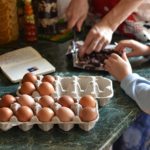 Getting kids involved in cooking is key to establishing long term healthy eating habits. And it’s a great way to keep them occupied in the summer, if you don’t mind your kitchen being a mess! Read our tips…..
Getting kids involved in cooking is key to establishing long term healthy eating habits. And it’s a great way to keep them occupied in the summer, if you don’t mind your kitchen being a mess! Read our tips…..
Why bother?
Getting your kids used to helping in the kitchen and preparing meals is a great life skill and an important step in establishing life-long healthy eating habits. Getting kids involved in the kitchen has been shown to increase healthy food choices and even reduce the risk of obesity in childhood and beyond. Apart from this, it helps to teach independence, decision making, planning, creativity, maths (adding ingredients), geography (talking about where different foods come from), science (how are different foods made?) and even physical dexterity.
Top tips
- Don’t be afraid of strong flavours, kids often love these. It’s important to introduce small children to a wide variety of flavours
- Encourage kids to taste rather than finish
- Get kids involved in choosing and planning meals and in shopping. Let them add the ingredients they need for their dish to the shopping list (if they can) and to put these in the trolley when shopping
- Don’t worry about the mess. But do get your kids involved in cleaning up too. This is (sadly) an important aspect to working in the kitchen
- Try to avoid only involving kids in baking treats. Teaching them to cook or help with meals is a more important skill
- Get present ideas to encourage cooking include age appropriate recipe books, personalised aprons or their own set of colourful knives if old enough. For younger kids, these Kuhn Rikon kids knives, also available in Stock Design in Dublin, make great presents
- Limit cooking choices for smaller kids. Don’t ask ‘what do you want to make?’. Give them two or three choices (hummus, cheese scones or yoghurt pots?) to avoid overwhelm
- Give age appropriate jobs. Don’t be afraid to challenge your kids but don’t give them jobs that are too difficult or they may become frustrated
What’s age appropriate?
Whether they are 2 months or 14 years old, there are ways to involve all kids in kitchen activities.
| Under 2 | Bring your child into the kitchen while you are cooking, so they can watch. Talk them through what you are doing and where appropriate, allow them to taste different ingredients. Give them robust implements like wooden spoons or measuring cups to play with |
| 2 – 6 years | At this age, kids are often keen to help. Make the most of it! Let them measure ingredients, stir, rinse fruit and veg, scrub potatoes, crack eggs, set timers, wipe down counter tops, make salad dressing and toss salad, help with washing up and drying, taste ingredients and finished products. Texture is important at this age, so talk to your kids about whether they like crunchy (carrot sticks), chewy (dried apricots) etc. |
| 6 – 12 years | Different kids develop fine motor skills at different levels. You are the best judge of what your child is able to do, but they are often capable of much more than we think. This is a great age to get kids involved in cooking projects like making fresh pasta, making probiotic cream cheese (also called labneh, more recipe ideas here), baking fresh bread or herb gardening. Kids of this age should also be able to use a veg peeler and grater (carefully!), crush garlic, whip cream, form burger patties, slice bread, use a small knife and cook at the stove with you supervising. They should also be able to help clearing up. |
| Teens | Anything goes here! A teenager should be well able to do anything in the kitchen that you can, although they may need a bit of help getting started. Encourage them to read the recipe through first and assemble ingredients before they start. Encourage them to think on their feet about improvising replacements for ingredients you don’t have at home e.g. using pears instead of apples, or plain flour with baking powder instead of self-raising flour |
Safety first!
The kitchen can be dangerous, with hot ovens and sharp knives, so it’s important to each your kids about safety. Make sure you supervise them appropriately and only use tools like knives when they are old enough. Show them the correct way to use peelers, graters, knives and when older, electrical tools. Talk to them about how to avoid burns, including turning saucepan handles in towards the stove. And don’t forget hygiene. Make sure the first step for everyone is washing hands and tying back hair and do the same yourself.
Don’t forget
Studies show that families who eat together at the table are happier and better connected. So even if your kids have been minimally involved in helping to prepare the meal or set the table, make the effort to eat at least your evening meal as a family as often as you can.
‘Kids in charge’ meal plan
| Breakfast | Low sugar crunchy granola with berries and natural yoghurt
Wholegrain toast with peanut butter and banana |
| Lunch | Omelette with tomato and spinach |
| Dinner | Baked cod topped with red pesto (make your own or use Happy Pear pesto), steamed veg, baby new potatoes
Asian salmon burgers with mixed salad |
| Snacks | Banana chocolate ‘ice cream’ or other healthier treats
Hummus (make your own or buy a good quality hummus e.g. Tesco organic) and veg sticks Summer berry smoothie – drink as it is or pour into lolly moulds and freeze for healthier fruit pops |
For other kid-friendly meal ideas, try Jamie Oliver’s ‘5 Ingredients‘ cookbook and website or Donal Skeehan’s ‘Eat, Live, Go‘ or ‘Meals In Minutes’ cookbooks. His website also has great kid friendly dishes and his one pan fajitas are a big hit in my house and easy enough for my 10 year old to get on the table.

